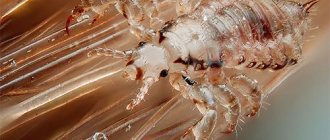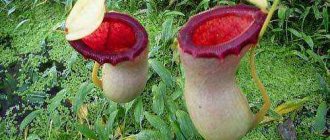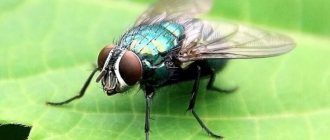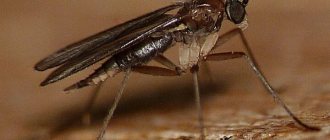Midges are a whole family of flying insects. There are about 1800 species. Midges live on all continents except Antarctica. Outwardly, these insects resemble ordinary flies. You can examine a midge (enlarged) under a microscope using an ordinary amateur model - even a children's microscope will do. A high magnification is not needed, 50-100x is enough. In fact, the midge can be studied even with a magnifying glass, although the number of details will be small. What can you see?
What does a midge look like when magnified under a microscope?
Midges are small insects, their body length does not exceed 6 mm.
The smallest representatives of this family reach a size of only 1.2 mm. The body structure of midges is divided into three main segments: head, abdomen, and chest. You can see what an ordinary midge looks like (enlarged) under a microscope in a photo on the Internet - it’s not difficult to find them. Let's look at the oral apparatus right away. Midge bites are always painful, often accompanied by severe swelling and even allergic reactions. And all because inside the mouth of blood-sucking midges there are many teeth, with which they saw through the path to their main food - blood. The same mosquito just carefully pierces the skin, but the midge actually tears off pieces of the epithelium with its powerful jaws. If you look at a midge under a microscope or at a photo of its oral cavity, the teeth will make an indelible impression - the difference with a mosquito’s proboscis will not be difficult to see.
Fun fact: not all midges are bloodthirsty. In fact, the males of many species are vegetarians. They feed on plant sap and flower nectar. Only females drink blood, and not only humans, but also cattle and birds are chosen as victims. Cats and dogs are usually ignored by midges. And it’s not surprising, we saw the midge under a microscope - although its jaws are powerful, they are still small, and it is difficult for the insect to break through the dense undercoat.
Types of midges
We have already mentioned that there are approximately 1,800 species of midges in the world. Let's talk about some of them.
Decorated midge. The insect's body length is from 3 to 4.5 mm. A distinctive feature is the silver border running along the back. The paws, abdomen and antennae can be of different shades. This species lives in the Palearctic region; insects can be found in Greenland, India and North America. All female decorated midges drink blood - animals and humans.
Horse midge. This is a small insect measuring from 2.5 to 4 mm. The hairs on the back and abdomen are golden-silver in color; on the shoulder fields of males you can see small silver spots. The insect lives in Karelia and Kamchatka, mainly near rivers and reservoirs. Females of this species drink the blood of humans and animals, and in horses they accumulate in the ears (hence the name of the species).
Red-headed midge. Body size: from 3 to 3.5 mm. A distinctive feature is red compound eyes. Females can be identified by their yellow legs; males have a silver pattern along their backs. This blood-sucking species lives in the European part of Russia and Eastern Europe. Insects prefer to live in silted ponds and rivers.
Tundra midge. Another evil bloodsucker. Prefers to settle in northern regions, most active at the end of summer and until the first half of September. The insect is small, the body size does not exceed 3 mm. The black back is covered with golden hairs, with a little silver on the sides. The abdomen is brown-black, the legs are black, the halteres are black-brown.
We will not be able to consider all types of midges in one article, so we will limit ourselves to the above. All of them, one way or another, are similar to each other. And since most of them bite strongly, we do not recommend studying them under a microscope live. If you are interested in looking at a midge under a microscope and seeing its jaws, it is better to turn to a photo - it is safer. Well, the most desperate ones can arm themselves with a microscope - our consultants will recommend a suitable model. Call, write - we will help you choose
Description of the appearance of the midge
A midge under a microscope looks very much like a fly. Its size is 2-3 mm and rarely exceeds 6 mm. The color of the insect body is gray. After a midge has bitten a person or animal and is fed with blood, it turns reddish. The midge's chest is convex. It is completely covered with small hairs. The midge's abdomen consists of 9 segments that form a single whole.
Midge (midge) under a microscope
Also on the body of the insect is a pair of wings. They are quite wide. If you look under a microscope, you can see that there are darkish patterns on the wings. They are what give the insect its gray color. The veins on the front part of the wing are dense and thickened. They are covered along their entire length with short hairs and spines.
The cubital vein on the wings forms a kind of fork without a stalk. The legs of the midge are thick and short. Two pairs of limbs are located in the lower part of the abdomen, and another one is located in the upper part. They are bent to the body and covered with small villi along their entire length.
The insect's head is facing down. It bears numerous short antennae. There is also a pair of eyes that occupy a large area on the side of the head. The midge's mouth is a complex apparatus. It consists of a fleshy shell, inside of which there are razor-sharp teeth-knives.
It is thanks to them that the insect can bite off a piece of flesh on the victim’s body, which causes it a lot of suffering. Moreover, its upper part also takes part in this process and is part of the piercing apparatus. The mouth and jaws of the midge are a piercing-sucking species. The lower jaw has the appearance of palps, which consist of 4 segments.
Midge bite under a microscope
It is with the help of such a complex mechanism that midges are able to so skillfully bite off part of the victim’s flesh. During an attack, a certain amount of anesthetic substance enters the skin along with the insect’s saliva. This makes the bite invisible, but after a while severe swelling, burning and redness appear.
Allergy to midge bite in a child
Also, the saliva of these pests contains toxic substances, which can lead to an allergic reaction. Such bites are especially dangerous for young children. They can cause a significant increase in body temperature, an inflammatory process occurs, and the wound itself often festers due to constant scratching. A peculiarity of this species is that only females attack people and animals during daylight hours and almost never at night. Males feed only on nectar from flowers.
The most common types of midges
Some species of midges feed on plant sap. It is enough for them to provide themselves and their offspring with the necessary nutrients. But under unfavorable conditions they can attack mammals. This helps them compensate for the deficiency of necessary substances to ensure their normal life cycle. The greatest danger comes from species that feed exclusively on blood. For their reproduction and normal functioning, it is necessary to constantly attack people and animals. Also, all species are carriers of dangerous diseases - plague, leprosy, anthrax and others.
Several types of midges are common in Russia:
- Odagmia spotted. They are bloodsuckers that can attack people and animals. Their larvae are found in rivers. The bites of these insects are very painful and can cause an allergic reaction; Midge (Odagmia ornata)
- creeping. Distributed in the tundra and rarely found in forest-steppe and steppe. They feed on blood; Creeping midge (Simulium repens)
- broad-legged. It is found in the tundra, sometimes in the steppe and forest-steppe. The need for blood in humans and animals develops when living in unfavorable conditions; A - midge Culicoides nebeculosus, B - broad-legged midge - Eusimulium latipes
- decorated. It also lives mostly in the tundra. Attacks people and animals. The bites are very painful;
- Kholodkovsky. A very aggressive insect that can attack even with the onset of cold weather;
- tundra It is most often found in the tundra, but can also live in neighboring areas. Causes a lot of harm to humans and livestock; Moshka Kholodkovsky
- river Distributed throughout Europe and Siberia. It feeds on the blood of animals and people.
Midges are quite dangerous. To protect yourself from them, you need to avoid daytime walks near bodies of water, on the banks of which there is a lot of vegetation. It is also recommended to wear clothing that covers most of the body in such places.
Population Reproduction
The female mosquito is the successor of the family and is responsible for bearing and hatching the eggs. Male mosquitoes are only responsible for fertilizing the female.
Life cycle
The mosquito can hatch up to one hundred and fifty eggs in one go. In a week, they hatch into larvae, which go through four stages of development in a month and transform into a pupa, from which an adult insect is formed after five days.
An interesting fact is that insects are ready to mate immediately after emerging from the pupae. Males choose more mature females for fertilization.
Lifespan
How long does a mosquito live? Often, the lifespan of a mosquito depends on its living conditions. The answer to this question will always be different.
How long do mosquitoes live in an apartment? Until they are destroyed using special means or a firecracker.
The lifespan of a mosquito in nature is much longer. Biological studies reliably show how many days a mosquito lives. The air temperature indicator tends to fluctuate, but the life expectancy of an insect depends on its value:
- at + 25°C it lives from 30 to 40 days;
- at + 20°C – up to 60 days;
- at + 15°C – up to 115 days;
- at + 10°C - up to 120 days.
How do mosquitoes spend the winter? After all, for example, hatched individuals in October experience cold weather due to their lifespan.
In winter, mosquitoes can take root in people's apartments and warm basements. Where do they winter in natural conditions? Rotten stumps, remnants of vegetation - leaves, moss, various burrows and crevices where they hide help them survive the winter. They are, one might say, hibernating. Physiological processes in the body of a fertilized female slow down, and she lays eggs as the weather warms up. And with the onset of cold weather, males die for lack of a food source - nectar.
Nutrition
Well-fed female mosquito
What do mosquitoes eat? The larvae have the opportunity to feed on particles of vegetation and microorganisms found in the water of the reservoir, which they pass through themselves. Adults survive on flower nectar. Then the question arises: why do mosquitoes drink the blood of humans and animals?
To bear and lay eggs, the female needs a lot of strength; nectar does not provide her with the necessary nutrients, while blood contributes to her complete saturation. This is why mosquitoes drink blood.
It should be noted that males do not bite, only females are voracious and in the moments after fertilization. The female mosquito sucks blood in order to gain strength and survive so that the population can continue to continue. If there is no source of blood nearby, then she dies after laying eggs, and her offspring are weak.
At one time, a mosquito can suck blood twice its weight, because the stretching abdomen is adapted to increase its size.
Midge: photo
Visually, midges look like small, most often black, flying dots. With good vision, you can sometimes see the wings and color of an insect more accurately.
- The sizes of midges usually vary between 1–4 millimeters.
- Insects of the family have 6 legs.
- The body has an elongated shape.
- The color, depending on the species, can be almost transparent, copper, brown or black.
- The flight of midges is most often smooth, but without a specific direction, they do not jump like mosquitoes.
- Unlike mosquitoes, midges are not afraid of extraneous movements; they can get into your eyes, mouth, nose, face and bite, not caring at all whether you pose a threat to them or not.
- Midges are most active at dusk, but can also bite during the day, especially if you disturb the grass near the places where they live.
- Midge larvae are worm-shaped and can reach a length of 4–8 millimeters.
You can see what a midge looks like in the photo, but keep in mind that large, detailed images are always taken with multiple magnification; you won’t be able to see the insect in such detail when you meet it.
Habitat
The midge most often lives in places with high humidity. Pests usually accumulate in last year's foliage and near water bodies. In mid-summer, the insect appears in the growing area of fruit trees and bushes. Parasites are attracted by the smell of spoiled food, so midges can often be seen near trash cans and in places where rotten vegetables accumulate.
Depending on the insect species, the habitat may vary.
The following types of midges are distinguished:
Drosophila - appears in rooms where there is missing food or garbage has accumulated;
clothes - the pest appears in dirty linen or wet things. Most often, this parasite appears near laundry bins or in the closet;
floral - pests accumulate in the soil. Occurs due to improper watering;
water - manifests itself in outdoor conditions near bodies of water, indoors in places where moisture accumulates.
Externally, insects have similar features and can attack humans. When a midge bites, it releases poison into the skin, resulting in swelling and redness.
Insect eggs can survive exposure to low temperatures. They are deposited on the fruits, and when optimal conditions arise, a new generation of midges appears in a short time.
What do midge larvae look like?
Female midges lay their eggs on the surface of the water. With the help of their powerful legs they cling to stones or plant stems. A characteristic feature of these insects is that their females can lay eggs in groups. As a result, they form entire colonies on the surface of the water.
Midge larvae in water
When the larvae hatch from the eggs, they are securely attached to any base with the rear end of their body. When magnified under a microscope, this part resembles hooks that are placed on powerful muscles. These larvae are largely immobile.
A careful examination reveals only a mouth that periodically fluctuates. Around it there are peculiar fans in the form of numerous processes, hairs and bristles. They are formed from the lateral parts of the upper lip. This is a complex mechanism that serves to catch food in fast flowing water conditions. Also on the small head you can see two pairs of eyespots.
Under a microscope, a cone-shaped process called a leg is clearly visible on the body of the larva. When an insect crawls to the surface, its body secretes a viscous secretion that facilitates movement. At the same time, during movement, the larva helps itself with this cone-shaped process. With its help, it is attached to any surface.
Midge larva
At the same time, the young individual pulls up the rear end of the body. Thus, it moves quite easily on any surface. The larva breathes over the entire surface of the body. She needs a lot of oxygen. An insect can only obtain it in a body of water with a fast current. In stagnant water, these pests most often die due to lack of oxygen.
Under unfavorable conditions, the larvae are capable of producing a web 2 m long. They can remain on it for a long time, after which they return to their original place. Before pupation, the young individual weaves a small pupa from sticky webs. It looks like a cover on which the doll is placed.
On its surface you can see a whole complex of breathing tubes that provide complete gas exchange for the insect. Adult midges leave the pupae after about 10-14 days. At the same time, they are enveloped in an air bubble, which lifts them to the surface of the water. This prevents insects from getting their wings wet.
Mosquitoes, ticks, midges in the country house, garden, vegetable garden and how to deal with them
Why do they start
Basically, small pests are caused by a person’s failure to comply with hygiene rules and pollution in the house. Mature individuals lay eggs on ripe fruits, and when we bring home vegetables and fruits, we also bring the eggs of these insects along with them. They need a rotting environment to develop, so as soon as the fruit begins to deteriorate slightly, the process of midge development from egg to adult will begin. Their life cycle is short, and their ability to reproduce is amazing. In a relatively short period of time they turn into a huge swarm.
Where do midges come from?
If midges bite you in a forest, park or country house, then the question of where they came from loses its relevance, since this is their natural habitat and, by and large, it was you who ended up on their territory, and not they on yours.
The situation is different when insects appear in apartments, houses, premises of organizations and companies. In this case, where the midges come from needs to be understood depending on the situation. Pests can get inside through:
- Gaps in trim, window and door frames
- Open windows and vents
- Ventilation ducts and shafts
- Sewer drains
Midges do not need large holes to get inside. The cracks through which they penetrate can be so small and invisible that no matter how hard you try, you won’t be able to find them. In this case, cosmetic or major repairs in potentially vulnerable areas can help.
When windows are open, midges often enter rooms by accident, but they can also be attracted to human food, sugary drinks and pet food. Despite the need for blood, most carnivorous midge species happily feast on:
- Fruits
- Vegetables
- Sweet drinks
- Beer
- Kvass
- Honey
- Jam
- Chocolate
- Decaying organic matter in a trash can
Some of this is in abundance, in the opinion of midges, in almost every room, so the strong smell of foods containing sugar and a garbage can can collect a swarm of thousands of insects in 1-2 hours. Individuals attracted by the aroma of food, which you may not even feel, can be either blood-sucking or herbivorous, but no less dangerous.
Location
The most common habitat for midges is, of course, flower pots. But the list doesn’t end there, especially if we’re talking about fruit flies that can eat garbage.
Finding a source of fruit flies is not easy, but it must be done, because otherwise the fight against them will drag on for a long time.
Kitchen - favorite room
If there are midges in your apartment, then first of all you should go to the kitchen. It is here that a warm and humid atmosphere is often maintained, which small insects, flies, and flies love so much.
Of course, if there are whiteflies or sciarids, then you should look in potted flowers. But if we are talking about fruit flies, then you will have to do a general cleaning in order to find the pest.
The main “danger spots” where you should look for annoying pests:
- window sill - often housewives put the finished dish on the windowsill to cool, or washed fruits, since there is no more room. Fruit flies will be happy to flock to such delicacies. And of course, the windowsill is a place where flowers often stand, which means all kinds of midges can settle here;
- sink - if you do not wash the sink thoroughly, then over time a greasy coating will form, which fruit flies will also be happy about, since, in their opinion, this is a delicacy. Another reason why they may appear at the sink is a clog in the filter or siphon. Pieces of food fall into the drain hole, but do not go further into the sewer and begin to rot. This is where the aroma appears that attracts midges. And the most banal reason is that they flew in from their neighbors;
- bulk products - due to improper storage of bulk products, such as cereals, flies, nuts, tea, midges can appear there. Moreover, we are not talking about home storage, but specifically in production or in a store - somewhere standards were violated;
- fruits and vegetables are the most obvious place to look for unexpected guests. Midges either come home with purchased products, or fly to their rotten smell.
Yes, there are many places in the kitchen where flies can live. But if you maintain cleanliness, it is almost impossible to meet annoying guests.
Bathroom - dampness is a joy
Another place in the apartment where a warm and humid atmosphere is maintained is the bathroom. Flies, of course, prefer the kitchen, but if there is nothing to profit from there, then you can fly through the water supply to your neighbors and feast on them.
If midges appear in the bathroom, this does not mean that the hostess is a slob. Yes, midges are attracted to unsanitary conditions, but there are many other reasons for their love of the bathroom:
- puddles forming on the floor due to leaking pipes;
- dampness;
- sewer pollution;
- poorly cleaned toilet:
- expired body care products.
And if there is a window in the bathroom, near which there is a flowering tree or a trash can, then there will definitely be no end to midges in such a room. It is best to avoid placing potted flowers in the bathroom, since the ever-damp soil can become moldy and serve as a luxury apartment for midges.
Why are midges dangerous?
Despite their size, midges can cause significant harm to people and animals.
- If you accidentally eat a fruit or vegetable infected with eggs and larvae of midges, this can lead to poisoning and intestinal infection.
- Bites from flesh-eating midges can be painful, cause an allergic reaction, and take a long time to heal.
- Bacteria and viruses can be transmitted through midge bites.
Regardless of whether you have herbivorous or carnivorous midges, they can and should be destroyed. You can do this yourself or with the help of SES. The Dez Group service, certified by Rospotrebnadzor, with more than 13 years of experience, will help you get rid of insects quickly, safely and with a guarantee of results on objects and territories of any scale and purpose.
Fight against midges
To combat midges in nature, the best way is to exterminate colonies of larvae. Due to the developmental characteristics of insects, namely the growth of offspring in water, the number of drugs available for control is significantly reduced. In this case, only microbiological agents can be used. These may be specially developed preparations for infecting the population of larvae with bacteria that are absolutely safe for other species of fauna.
Sometimes, to reduce the number of midges, fish are released into the reservoir: ruffe, roach, ide, grayling, which actively feast on midge larvae. Mechanical cleaning of reservoirs near populated areas is carried out to reduce the number of midges.
Adult insects are exterminated with insecticides by treating vegetation.
Protection against midges
To prevent an insect bite, a person should adhere to a number of rules:
- Wear protective clothing that midges cannot bite through;
- Use repellents as protection;
- Use mosquito nets;
- Take into account the time of midge activity;
A midge bite can cause allergic reactions, itching and infection of the skin. That is why it is necessary to take all precautions to protect yourself from the attacks of these insects.
Do dichlorvos and fumigator help?
Dichlorvos is a very effective remedy for midges, but the owners don’t like it either. The leaves of plants can be burned with dichlorvos, so it is better to spray them into the ground. As a last resort to kill the larvae, this drug is suitable.
If possible, it would be better to poison insects in other ways.
As for fumigators, their effectiveness depends on the composition that serves as a source of an aroma unpleasant to insects. It is necessary to connect the device to an electrical network, otherwise the smell will not be released because the special plate soaked in the odorous solution or the liquid in the bottle screwed to the fumigator does not heat up.
The product is highly effective in combating not only midges, but also mosquitoes, flies and other insects.
Protection against midges outdoors
Adjusting your outdoor schedule to the life cycle of a particular midge species is too much and a waste of time. You should turn to more effective insect control options.
Professional approach
There are two types of products that repel midges from the human body: repellents and fumigators. The first ones are applied directly to the skin, the second ones destroy insects within a certain radius.
Repellents (sprays, ointments, lotions)
They are applied to the skin, thereby blocking the olfactory receptors of insects.
- Mosquitall ointment based on diethyltoluamide. Effectively repels midges for 8–9 hours, disorienting the olfactory receptors of insects. Has a pleasant vanilla scent.
- Aerosol Help. Valid for 6–8 hours. Apply to skin and/or clothing. It is dangerous for children under 12 years of age, pregnant and lactating women to use the product.
- Aerosol Gardex based on diethyltuolamide. Lasts 4.5–6 hours.
Aerosol is the most convenient form of repellent
Fumigators
Contains toxic substances that kill midges. Fumigators can be of two types:
- pyrotechnic (the spiral smolders and smokes, releasing substances toxic to midges);
- electric (under the influence of heat, a plate soaked in poison or a bottle with toxic liquid releases these substances into the air and kills midges).
The most popular and effective fumigators are products from the Raid, Mosquitall, and Fumitox brands.
Spiral fumigators are convenient to use outdoors, but their coverage area is not very large
Folk methods of protection
If the use of chemicals contradicts your principles, you can use folk advice.
- Infusion with vegetable oil. Leaves of wormwood, parsley, tobacco, eucalyptus or fir sprigs, vanilla pods, anise seeds, clove buds are infused in oil for 2-3 weeks. After straining the mixture, apply it to exposed areas of the body.
- Ointment based on baby cream or Vaseline. Grind lavender leaves, basil, rosemary, bird cherry blossoms or garlic cloves, lemon zest and mix with the base. Apply as needed.
- Alcohol tincture. In 500 ml of 35% vodka, put 250 g of walnut shells, add 10-15 drops of camphor oil (or 30-40 drops of peppermint oil), leave for 2 days. We lubricate exposed areas of the body, except the face, as alcohol can cause burns.
- Essential oil mixtures. Strong smells repel midges, while many people enjoy this type of aromatherapy.
Table: Effective Essential Oil Blends
| Composition | Ingredients |
| Mint-lavender | 5 drops of lavender oil; 5 drops of mint oil; 20 drops of citronella oil; 0.5 liters of water. |
| Lemon-basil | 5 drops of lemon oil; 20 drops of citronella oil; 10 drops of basil oil; 0.5 liters of water. |
| Vanilla-lavender | 5 drops vanilla oil; 20 drops of citronella oil; 5 drops of lavender oil; 0.5 liters of water. |
Prevention
Since midges, judging by the species table, inhabit the entire globe, with the exception of some northern corners and deserts, it is, to put it mildly, useless to fight the very existence of these insects. All that remains is to choose a means of protection against their bites and listen to the recommendations of experts:
- You should not choose places for walks or picnics near bodies of water overgrown with vegetation;
- at the height of summer there is no need to wear too revealing light clothes;
- You should not stay for a long time in damp shady forests and near swampy lowlands;
- It is better to organize walks and picnics away from livestock farms.
Ways to get rid
The appearance of midges in the house is a problem that requires close attention. At first, their appearance may go unnoticed, but given their rapid reproduction, they will soon begin to cause serious harm. Some varieties of midges require an individual approach to destruction, but most can be exterminated using standard methods.
Classic methods
Classic methods are usually the most reliable
They can help get rid of insects in a short time, but they require certain precautions
Most often used in the fight against midges:
- Aerosols against insects. The compositions “Dichlorvos”, “Kombat”, Raid still help cope well with pests. Use them strictly according to the instructions, not forgetting about protective equipment.
- Fumigator. Most often, the device is used against mosquitoes, but it is also effective in the fight against other insects. You just need to find plates or a special liquid against flies.
- Sticky traps. Unlike sticky tape, which is often used against flies, these traps are much easier to use.
- Light trap zappers. Devices based on electrical stimulation of insects are not very effective as the main weapon against midges, but can help as an auxiliary tool.
Thus, surfaces must be treated strictly with gloves and, preferably, a respirator or mask to avoid exposure to toxic substances. Do not use sprays or other products near food or children's toys. There should be no children or pets in the apartment during treatment.
Tick under a microscope
There are a lot of species of ticks, but we will dwell in detail on ixodid (encephalitis). This is not a very exciting subject to study, but it is useful to know the details. This is what a tick looks like under a light microscope. By the semicircular dark brown shell on the body, you can determine that it is a female. The male has a larger shell and is located throughout the abdomen. The female can attach itself to the body for 6-7 days, the male is smaller - for about 20 minutes. The female swells from increased nutrition, and she becomes 200 times larger: from 0.5 cm in length, she increases to 3 cm. Her paws are almost hidden under her abdomen. Such a female goes to lay eggs in the most secluded place. To feast on blood, the tick makes its way through the body very quietly, and special suction cups on its legs help it with this. This is the mouthparts of a tick. The central part is chelicerae. They clearly show teeth that are located in the opposite direction, like those of a pike. With the help of teeth, the tick is securely attached to the skin, and you can pull it out by twisting it counterclockwise. Chelicerae protect the palps on both sides. When a tick bites, it injects an anesthetic, so it can only be detected after it has firmly attached itself and the bite site is inflamed. Perhaps he gave you a dangerous disease: encephalitis or borreliosis.
Mosquito under a microscope
Oh, those mosquitoes! Perhaps they are not loved throughout the world. They continue to be annoying even at night thanks to infrared vision. They identify their prey by carbon dioxide and the smell of sweat even at a distance of 60 meters. There are 150 receptors for this. Small, smooth insects with a nose look different under a microscope. The visual organs are of great interest. They consist of many individual eyes that see objects in a 380-degree mosaic around them. This is the wing of a mosquito. There are many small hairs on it. These hairs are located throughout the body. They protect the mosquito from getting wet. The most interesting part is the proboscis or nose. With the naked eye we see a ton-sized needle, but in fact it is a complex oral apparatus. The proboscis is soft; inside it there are six needles, each of which performs its own function. Some pierce the skin, others find a blood vessel and suck the blood, and still others hold the edges of the wound. There are 50 teeth on two needles. These are nose holders in the skin. All this can only be seen with an electron microscope. This is what a mosquito's teeth look like on a needle.
When a mosquito bites, it injects a thinning substance into the blood so that the blood does not clot, which makes it easier for it to feed. This substance causes allergies, so the bite site is very itchy.
Mosquito "singing"
There is no need to remind you once again what sound a mosquito makes. Of course, when they fly, a nasty, annoying squeak reaches a person’s ears. Where is it coming from? From the mouth of an insect? Not at all! It is the high frequency of oscillations of the mosquito’s wings that is the very instrument that contributes to the production of a squeak, which subsides at those moments when the insect simply sits on the “victim” or rests on other objects in its habitat, with its wings folded.
It often seems that there is a whole swarm of insects in the room instead of one or two, the squeak is so loud that it can cause insomnia in people.
Fly under a microscope
The fly is one of the most common insects. She lives wherever there are people and there are favorable living conditions.
Under a microscope, it is clearly visible that the entire body of the fly is covered with hair. Hairs, as well as large wings, protect it from getting wet. This is the hairy belly of a fly. On the fly's head there are antennae - this is the organ of smell. Most of the head is occupied by the eyes. They consist of 4 thousand facets and see 360 degrees around them. Plus, the fly has lightning-fast reactions, making it difficult to catch.
The housefly's proboscis is soft and can only absorb liquid food. If the fly likes a hard piece, then it actively begins to inject digestive enzymes into it so that it breaks down. She tastes the food with her paws. They contain taste receptors. She rubs her paws against each other all the time, clearing away any stuck-on debris.
But the autumn fly - a blood-sucking fly - has a sting with which it bites painfully. In autumn, this type of fly becomes especially angry, as they try to stock up on protein for breeding.
Prevention of occurrence
- Check stored food regularly for signs of rotting. As soon as they appear, throw away the spoiled ones.
- Clean up and take out trash in a timely manner, and wash the trash can.
- Clean sewer pipes and siphons periodically.
- Don't forget to take care of the animals and the aquarium on time.
- Do not leave dirty dishes for a long time.
- Make sure that the water in the trays with plants does not stagnate. Avoid overwatering plants.
- Keep your apartment or house clean. Do general cleaning once a week.
How to protect yourself from midge bites
You need to know that the midge has its own daily routine; it is very active on a warm sunny day in the morning and evening before sunset, and also before rain. Twilight and at night she is passive. It lives mainly in places of tall grass, trees and near water bodies.
- When going for a walk, wear thick clothes with long sleeves.
- When going fishing, hunting and mushrooms, take mosquito nets and mosquito nets.
- Various fumigators will help in the apartment.
- Various chemical repellents (insect repellents) in the form of spirals, tablets and scented candles work well outdoors.
- Your best assistant is pharmaceutical products in the form of sprays, ointments, and balms. Available for both adults and children.
Home remedies: midges, like many insects, cannot tolerate strong odors. For example, clove oils or old clove cologne. Vanillin (crystallized) is diluted with water and used as a spray; it can be used to treat both clothes and a child’s stroller. When getting ready for an overnight stay, you can sprinkle vanilla on your clothes.
How does a midge bite under a microscope?
The mouth of a midge is a complex apparatus, which includes a shell and teeth. The teeth are sharp, together in the upper jaw they belong to the ring - sucking species, which is why these insects bite through the flesh of their victims. The lower jaw has 4 segments. During a bite, along with saliva, a certain amount of anesthesia is released onto the surface, which makes the bite invisible and painless. Only after some time does swelling, burning, and redness appear. Along with anesthesia, toxic substances are also released in the saliva of midges. They are especially dangerous for people with allergies.
What are the dangers of midge bites for humans?
After a midge bite, most people experience a standard reaction that lasts quite a long time, but when therapeutic measures are taken, it goes away without any consequences for the victim’s health. In some cases, an attack by this insect can cause such a dangerous phenomenon as an allergy, which, if the symptoms are ignored, untimely or improperly treated, can lead to death.
Normal reaction: how does it manifest itself, how long does it last?
Midges bite in all parts of the body without exception. They don't have favorite places. A bite from a midge can affect the leg, arm, face, stomach, and back. Most often, it is the limbs that are affected - the most exposed parts of the body. At the time of the attack, the victim does not feel any discomfort, because the saliva of these insects contains an anesthetic.
Severe redness, pain, itching, burning and swelling, in the center of which you can see a red dot, appear later. Depending on your immunity, the first signs may appear within 10–20 minutes or after a few days. Possible increase in body temperature.
The severity of the symptoms that appear after a child or adult is bitten by a midge depends on many factors:
- number of attacked insects;
- state of the immune system;
- age of the person bitten;
- predisposition to allergic reactions.
What causes this body reaction to the bite of this insect? Redness, swelling and acute pain are associated with the fact that midge saliva, in addition to the analgesic component, contains:
- an anticoagulant secretion that blocks the functioning of the coagulation system, so that the pest has time to feed on blood;
- a hemolytic toxic substance that causes redness and swelling of the skin;
- histamines;
- enzymes.
The swelling from a midge bite is much more extensive than from a mosquito bite, and accordingly, the pain is more pronounced. This is due to the fact that during an attack, the mosquito cuts the skin, injecting saliva into the wound, causing bleeding, while the mosquito pierces the flesh with a thin proboscis, sucking blood from a capillary vessel.
Manifestations of allergies
Enzymes contained in the saliva of these insects, if they enter the wound during a bite, can provoke the development of a severe allergic reaction—simulidotoxicosis. When, for example, the leg is swollen after an insect bite, the affected area itches, hurts and itches, but in general the condition of the bitten person is satisfactory - there is no need to worry, you just need to observe the victim. The following symptoms indicating the development of an allergy require immediate treatment measures:
- Severe itching, burning, intradermal hemorrhage, swelling and redness, tending to worsen.
- Signs of general intoxication of the body, appearing 3–5 hours after a midge attack: a sudden increase in body temperature to 38–39°C, severe chills, weakness, muscle, joint and headaches, impaired breathing and heart rhythm.
- Inflammation of the lymph nodes. The lymph nodes become inflamed after 5–8 hours, the time depends on the number of bites and the individual characteristics of the body. This condition can last up to 14 days.
As allergies develop, anaphylactic shock may occur. The listed symptoms cannot be ignored. In severe cases, inaction can cause the death of the victim. If one of the family members was bitten by a midge, after which he began to lose consciousness and become delirious, he must be immediately taken to the nearest medical facility. In this situation, every minute matters.
Why does swelling occur from a midge bite?
No one is surprised by the fact that a bee sting is almost always accompanied by swelling of the area near the skin puncture site. But the bee is a large insect, and besides, it leaves toxic substances in the skin that cause intoxication and a strong allergic reaction. Is it really possible that a midge, whose size is barely more than 1 mm, can also poison the human body?
Let's start with the fact that the provocateur of a bee or wasp sting is usually the person himself, in whom the insect saw danger. Bees bite a person not out of hunger, but for the purpose of self-defense, which is why they inject poison, which should, as it were, paralyze the enemy. But mosquitoes, horseflies, and midges belong to the category of blood-sucking insects that use humans as a vessel with nutrients. Their attacks have a completely different goal - saturation.
It must be said that all blood-sucking insects, which include midges (a microscopic type of midge), contain toxic substances and anesthetics in their saliva. First, the insect injects saliva, which numbs the bite site, and then begins to eat. The mosquito pierces the skin and sucks out the blood, while the midge confines itself to taking a small piece of the epithelium. But since at first we are under the influence of an anesthetic, we can feel a prick or burning sensation even when our body has already lost a good portion of blood or flesh. In this case, the culprit of the event himself may already be out of reach.
At the site of the midge bite, as in the case of other insects, swelling may appear. Usually the appearance of such a reaction is associated with the characteristics of the victim’s body. Edema is an allergic reaction to the introduction of insect saliva into the body, which contains allergens.
They can be both anesthetic substances and other components contained in the saliva of insects. It is not for nothing that these small pests are considered carriers of various viral, bacterial and parasitic infections. People see this as their main danger. The penetration of foreign substances into the tissues or blood of the human body, such as bacteria, viruses, eggs and larvae of parasites, is accompanied by the development of an inflammatory process, which is actually a type of allergic reaction.
What happens during a midge bite and why does it cause tissue swelling? Let us consider the pathogenesis of this process. When an allergen from an insect's saliva enters the body, a complex process inside the body is triggered. When B lymphocytes, synthesized by our immune system, meet antigens contained in foreign substances, the lymphocytes begin to produce antibodies, which, along with T lymphocytes, attack the allergen.
When an allergen first enters the body, a violent reaction may not be observed, because the production of antibodies is a matter of time, but at the same time sensitivity to the allergen increases. And when a repeated bite occurs, an active struggle between the protective lymphocytes and previously produced antibodies with the invading allergen begins. Such a struggle always has external manifestations.
As a result of the interaction of the allergen and antibodies on the surface of the cell, intracellular free calcium penetrates into it, which enhances metabolism. This is a signal for the production and release of allergy mediators: histamine, heparin, prostaglandins and some other enzymes.
The development of tissue edema is associated with the release of histamine. This enzyme increases the permeability of vascular tissue membranes, which facilitates the circulation of fluid between soft tissues and vessels. Fluid begins to accumulate in the tissues, causing their volume to increase. This process is called edema. And the inflammatory response, manifested by swelling, redness and pain, is associated with an increase in the production of prostaglandins.











